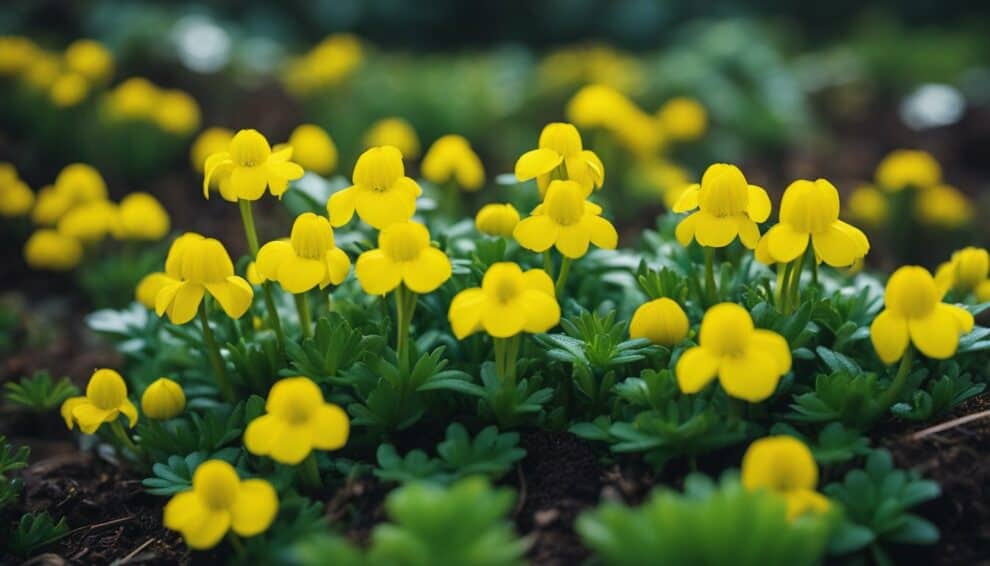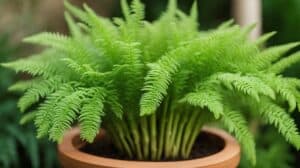Winter aconite, also known as Eranthis hyemalis, is a beautiful and low-maintenance flowering plant that is perfect for beginners. This plant is a member of the buttercup family and is native to Europe and Asia. It is known for its vibrant yellow flowers that bloom in late winter or early spring, often before other plants have started to grow.

Winter aconite is a hardy plant that can survive in a variety of soil types and light conditions. It prefers well-draining soil and partial shade, but can also grow in full sun or full shade. This makes it a versatile plant that can be grown in a variety of garden settings. Additionally, winter aconite is a naturalizer, meaning that it will spread and multiply over time, creating a beautiful carpet of yellow flowers in your garden.
Getting to Know Winter Aconite
Winter Aconite (Eranthis hyemalis) is a charming perennial plant that belongs to the buttercup family. It is native to Europe and Asia, and it is widely cultivated in gardens for its early spring blooms. Here’s what you need to know about Winter Aconite.
Botanical Profile
Winter Aconite is a low-growing plant that typically reaches a height of 3 to 6 inches (7 to 15 cm). It has attractive, cup-shaped flowers that are bright yellow in color. The flowers appear in late winter or early spring, and they are among the first blooms to emerge after the winter dormancy. The plant has a basal rosette of dark green, lobed leaves that emerge after the flowers have faded. The leaves are approximately 2 to 4 inches (5 to 10 cm) in diameter and have a glossy texture.
Origin and Habitat
Winter Aconite is native to the woodlands and meadows of Europe and Asia. It is commonly found in deciduous forests, along stream banks, and in rocky areas. The plant prefers moist, well-drained soils and partial shade. It is hardy to USDA zones 3 to 7 and can tolerate temperatures as low as -40°F (-40°C).
In gardens, Winter Aconite is often planted in rock gardens, woodland gardens, and under deciduous trees. It naturalizes readily and forms dense colonies over time. It is an excellent plant for early spring color and can be used to brighten up shady areas of the garden.
Overall, Winter Aconite is an easy-to-grow plant that requires minimal care. With its cheerful blooms and attractive foliage, it is a great addition to any garden.
Planting Winter Aconite

Winter Aconite is a beautiful, low-growing perennial that blooms in late winter to early spring. If you’re interested in growing this delightful plant, it’s important to know how to plant it properly. In this section, we’ll cover everything you need to know about planting Winter Aconite.
Choosing the Right Location
When choosing a location for your Winter Aconite, it’s important to find a spot that gets plenty of sunlight. This plant needs at least 6 hours of direct sunlight each day to thrive. You should also choose a location that has well-draining soil, as Winter Aconite does not like to sit in water.
Soil Requirements
Winter Aconite prefers soil that is rich in organic matter and has a slightly acidic pH level. If your soil is too alkaline, you can amend it with peat moss or sulfur to lower the pH level. You should also make sure that the soil is well-draining, as Winter Aconite does not like to sit in water.
Planting Guidelines
To plant Winter Aconite, you should follow these guidelines:
- Dig a hole that is about 2-3 inches deep and 2-3 inches wide.
- Place the Winter Aconite bulb in the hole with the pointed end facing up.
- Cover the bulb with soil and gently press down to remove any air pockets.
- Water the area thoroughly to help settle the soil.
It’s important to plant Winter Aconite in the fall, before the ground freezes. This will give the bulbs enough time to establish roots before the winter weather sets in. Once planted, Winter Aconite requires very little maintenance and will come back year after year.
By following these planting guidelines, you can ensure that your Winter Aconite will thrive and provide you with beautiful blooms year after year.
Maintenance and Care

Watering Needs
Winter Aconite plants require regular watering during the growing season. They prefer moist but well-draining soil, so it’s important not to let the soil dry out completely. This can be achieved by watering the plants deeply once a week or more frequently during hot and dry weather conditions. It’s also important to avoid overwatering, as this can lead to root rot.
Fertilizing
Winter Aconite plants don’t require heavy fertilization, but a light application of balanced fertilizer during the growing season can help promote healthy growth and flowering. Use a slow-release fertilizer or apply a liquid fertilizer every 4-6 weeks. Be sure to follow the instructions on the fertilizer package and avoid over-fertilizing, as this can lead to excessive foliage growth at the expense of flowers.
Pruning and Deadheading
Winter Aconite plants don’t require extensive pruning, but removing dead or damaged foliage can help promote healthy growth and prevent the spread of disease. Deadheading spent flowers can also help promote continuous blooming throughout the season. To deadhead, simply pinch off the spent flower heads or use a pair of pruning shears to cut them back to the base of the stem.
Overall, Winter Aconite plants are relatively low-maintenance and easy to care for. By following these simple tips, beginners can enjoy a beautiful display of bright yellow flowers in their winter garden.
Common Issues and Solutions

Pest Problems
Winter Aconite plants are generally not susceptible to any serious pest problems. However, they can be affected by common garden pests such as slugs and snails. These pests can cause damage to the plant’s leaves and flowers. To prevent damage, gardeners can use slug bait or copper tape around the base of the plant. Another option is to handpick the pests and remove them from the area.
Disease Prevention
Winter Aconite plants are relatively disease-resistant. However, they can be affected by fungal diseases such as powdery mildew and root rot. To prevent these diseases, gardeners should ensure that the soil is well-draining and not overly wet. They should also avoid overcrowding the plants, which can lead to poor air circulation and increased humidity. If a fungal disease is detected, gardeners can use a fungicide to treat the affected area.
Handling Weather Extremes
Winter Aconite plants are hardy and can tolerate cold temperatures. However, they can be affected by extreme weather conditions such as frost and heavy snow. To protect the plants from frost, gardeners can cover them with a layer of mulch or a frost cloth. Heavy snow can also damage the plants, so gardeners should gently remove any excess snow from the plant’s leaves and flowers.
Overall, Winter Aconite plants are easy to care for and do not require much attention. By following these simple tips, gardeners can ensure that their Winter Aconite plants thrive and provide a beautiful display of early spring flowers.
Frequently Asked Questions

How do you take care of winter aconite?
Winter aconite is a low-maintenance plant that requires little care. It prefers well-draining soil that is rich in organic matter. It is important to keep the soil moist during the growing season, but avoid overwatering. It is also recommended to fertilize the plant once a year in the fall with a balanced fertilizer.
Where is the best place to plant winter aconite?
Winter aconite grows best in partial shade to full sun. It is often planted under deciduous trees or shrubs where it can receive sunlight in the early spring before the leaves emerge. It is also important to plant winter aconite in a location that has well-draining soil to prevent the bulbs from rotting.
Is winter aconite easy to grow for beginners?
Yes, winter aconite is easy to grow for beginners. It is a hardy plant that can tolerate cold temperatures and is not affected by pests or diseases. It is also a self-seeding plant, meaning that it will spread and naturalize over time.
Are winter aconite bulbs sensitive to how they are planted?
Yes, winter aconite bulbs are sensitive to how they are planted. It is important to plant the bulbs with the pointed end facing up and to plant them at a depth of 3-4 inches. It is also recommended to plant the bulbs in groups of 10-15 to create a more dramatic effect.
What should I do if I want to remove winter aconite from my garden?
If you want to remove winter aconite from your garden, it is recommended to wait until the foliage has died back naturally. Once the foliage has died back, you can dig up the bulbs and either replant them in a different location or discard them.
What is the significance of the winter aconite flower?
The winter aconite flower is a symbol of hope and new beginnings. It is one of the first flowers to bloom in the spring, often appearing when there is still snow on the ground. The bright yellow flowers are also a source of nectar for early emerging bees and other pollinators.














